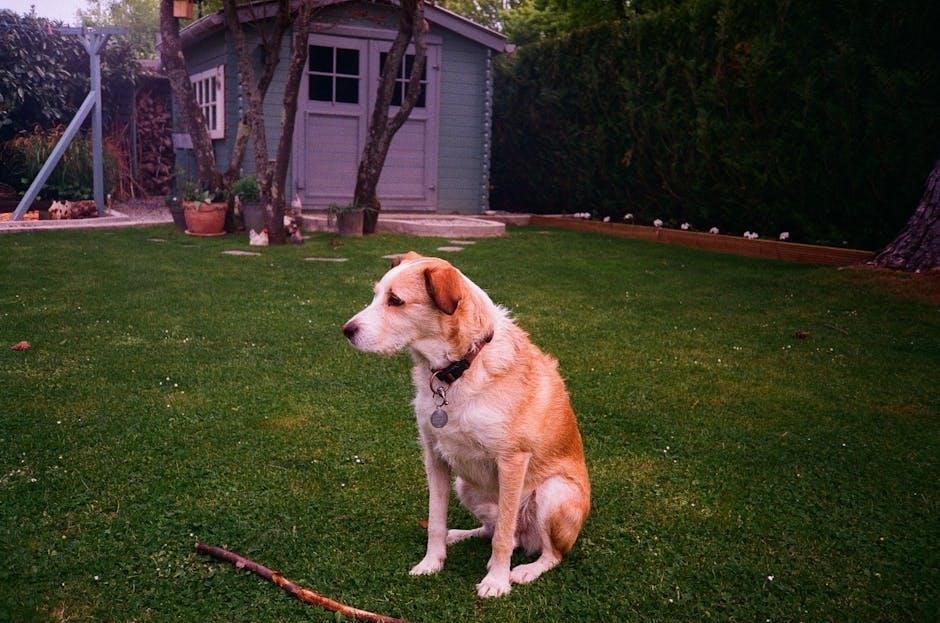Building a Giantz garden shed is a great way to organize your outdoor space. This guide provides detailed assembly instructions to help you construct your shed safely and efficiently. Follow these steps to ensure a successful installation and enjoy your new storage solution for years to come.

Safety Precautions
Always wear gloves during assembly to prevent injuries. Avoid building on windy days, as shed panels may be blown away. Ensure a solid, level foundation to guarantee stability and safety.
General Safety Tips

When assembling your Giantz garden shed, always prioritize safety to avoid accidents. Wear protective gloves to prevent cuts and abrasions from sharp metal edges. Ensure the assembly area is clear of clutter and tripping hazards. Avoid assembling during windy conditions, as panels may become difficult to handle and pose a risk. Never lean or stand on the roof or walls, as this can cause structural damage or personal injury. Use proper lifting techniques to handle heavy components, and consider having a second person assist with larger or heavier parts. Keep all tools and small hardware organized to prevent misplacement or accidental damage. Ensure the shed is properly anchored to the ground to prevent wind damage. Follow all instructions carefully, and take regular breaks to avoid fatigue. Safety should always come first to ensure a successful and stress-free assembly process.

On-Site Assembly Risks
Several risks are associated with on-site assembly of your Giantz garden shed. One major concern is improper leveling of the ground, which can lead to uneven surfaces and structural instability. Additionally, missing or damaged parts can delay the process and compromise the shed’s integrity. Windy conditions pose a significant hazard, as loose panels may become difficult to control, increasing the risk of accidents. Incorrect use of tools or failure to follow instructions can result in damaged components or unsafe assembly. Moreover, attempting to assemble the shed alone, especially with larger models, can lead to injuries or improper construction. It is crucial to address these risks by ensuring a level foundation, verifying all parts are present and undamaged, assembling in calm weather, and seeking assistance when needed. Being aware of these potential issues can help ensure a safe and successful assembly process for your garden shed.
Site Preparation

Ensure the area is clear of debris and vegetation. The ground must be flat and firm to support the shed’s foundation. Proper preparation is essential for a smooth assembly process.

Foundation Requirements
A solid, level, and square foundation is essential for proper shed assembly. The base must be constructed to support the weight of the shed and ensure stability. A concrete slab, 75mm thick and reinforced with SL62 mesh, is highly recommended. This provides a durable and even surface for the shed. Additionally, a rebate cast into the concrete can help prevent water leakage around the base. Ensuring the foundation is square and level is critical to avoid structural issues during assembly. If the foundation is not properly prepared, it may lead to misalignment of panels and potential damage from wind or rain. Always follow the manufacturer’s guidelines for foundation specifications to guarantee a secure and long-lasting installation. Proper preparation at this stage will make the assembly process much smoother and ensure your shed remains safe and functional for years to come.
Leveling the Ground

Leveling the ground is a critical step before assembling your Giantz garden shed. Ensure the site is clear of grass, debris, and obstructions. Use a spirit level to check the surface for evenness. If necessary, dig the ground slightly to create a flat base. Compact the soil firmly to prevent settling. A slight incline can be introduced to improve water drainage. Once the ground is prepared, lay a layer of compacted sand or gravel to provide a stable surface. Double-check the area with a spirit level to confirm it is perfectly horizontal. Proper leveling ensures the shed stands securely, prevents water pooling, and aligns doors and panels correctly. This step is essential for a smooth assembly process and long-term durability of your shed.

Tools and Materials Required
To assemble your Giantz garden shed, ensure you have the following tools and materials ready. Essential tools include a screwdriver, wrench, drill, and spirit level. Protective gear like gloves and safety glasses is recommended. A rubber mallet may be useful for aligning parts without causing damage. Additional materials such as a concrete slab or wood base for the foundation are necessary for stability. Check the packaging for all included hardware, such as screws, bolts, and brackets. If any parts are missing or damaged, contact the manufacturer immediately. Having all tools and materials prepared will streamline the assembly process. Refer to the provided instructions for a detailed list of required tools and components. Ensure you have a second person to assist, as some components may be heavy or difficult to manage alone. Proper preparation ensures a safe and efficient assembly experience.

Step-by-Step Assembly Guide
Begin by assembling the floor frame, then install the walls and panels. Next, attach the roof and doors, ensuring all parts are securely fastened; Follow the manual for detailed guidance.
Assembling the Floor Frame
Start by laying out all floor frame components on a level surface. Identify and label each part according to the manual. Use a wrench to secure the corners with bolts, ensuring tightness. Next, attach the side rails to the corners, aligning them carefully. Use screws to fasten them in place. Now, install the center support beams to add stability. Tighten all connections firmly. Finally, double-check that the frame is square and level before moving on to the walls. This step is crucial for a stable shed structure. Wear gloves to protect your hands during assembly. If unsure, refer to the manual or seek assistance. Properly assembled, the floor frame will support the entire shed securely.
Installing Walls and Panels
Begin by attaching the side panels to the floor frame using the provided screws. Ensure each panel is aligned with the pre-drilled holes and securely fastened. Next, install the back and front panels, making sure they fit snugly into the frame. Use a spirit level to confirm the panels are upright and the structure is square. Once the walls are in place, attach the roof support beams to the top of the panels for added stability. Finally, secure the panels together at the corners using the supplied brackets. Tighten all screws firmly to ensure a rigid structure. Always wear gloves to protect your hands during assembly. If panels feel loose, double-check alignments and tighten connections. Proper installation of walls and panels ensures a stable base for the roof and doors. Work with a partner for easier handling of larger panels. Avoid assembling on windy days to prevent panel damage.
Attaching the Roof and Doors
Start by assembling the roof panels according to the manufacturer’s instructions. Place the panels onto the top of the walls, ensuring they align with the pre-drilled holes. Secure the panels using the provided screws, working from the center outward to avoid buckling. Once the roof is in place, attach the ridge cap to cover the gap between the two roof sections; Tighten all screws firmly to create a watertight seal. For the doors, attach the door frames to the front wall using hinges and screws. Ensure the doors are level and properly aligned before securing them. Install the door handles and locks according to the instructions. Double-check all connections to ensure the roof and doors are securely fastened. Wear gloves to protect your hands during this process. If any parts feel loose, tighten them immediately to maintain structural integrity. Proper installation ensures your shed remains secure and weatherproof. Work with a partner for easier handling of roof panels. Avoid over-tightening screws to prevent damage to the materials. Use a spirit level to confirm the doors are evenly aligned and functioning smoothly. This step completes the structural assembly of your Giantz garden shed.

Common Issues and Solutions
Missing parts or damaged components can delay assembly. Contact customer support for replacements. If instructions are unclear, refer to online resources or video guides for clarification. Ensure all panels are properly aligned before securing them. If screws are difficult to tighten, check for misaligned holes. Use a rubber mallet to gently tap parts into place. For roof leaks, inspect and tighten all roof panel screws. If doors are uneven, adjust the hinges or check the frame alignment. Consult the troubleshooting section for specific solutions to common assembly issues. Always follow safety guidelines when addressing problems. If unsure, seek assistance from a second person or professional. Regular maintenance can prevent future issues. Keep all hardware tightly secured to withstand weather conditions. Addressing problems promptly ensures the longevity of your shed. If parts are damaged, replace them immediately to avoid further damage. Use the provided wrenches and tools to avoid stripping screws. If panels are dented, carefully hammer them back into shape. For windy conditions, ensure the shed is anchored properly. If assembly takes longer than expected, take breaks and revisit the instructions. Consider labeling parts as you unpack them for easier reference. If a step seems unclear, re-read the instructions or watch a tutorial. Ensure all safety precautions are followed to prevent accidents. If you encounter a problem, do not force parts together, as this can cause permanent damage. Instead, reassess the step and adjust as needed. Keep the assembly area clean to avoid losing small parts. If you are unsure about a specific part, refer to the parts list or diagram. Use a level to ensure all sections are properly aligned. If the roof does not fit securely, check the wall alignment and adjust as necessary. For persistent issues, contact the manufacturer or a professional for assistance. Remember, patience and careful planning are key to a successful assembly. Always prioritize safety and take breaks if needed. With careful attention to detail, you can overcome most common issues and complete the assembly successfully.
Troubleshooting Missing or Damaged Parts
If you encounter missing or damaged parts during assembly, stop immediately and verify all components against the provided parts list. Double-check the packaging to ensure no items were overlooked. If parts are missing, contact the manufacturer or supplier for replacements. For damaged components, inspect for minor dents or scratches that can be repaired. If a part is unusable, request a replacement promptly. Use the contact information provided in the manual or website. Refer to online resources or forums for temporary fixes if waiting for a replacement. Labeling parts as you unpack can help prevent misplacement. If instructions are unclear, consult the troubleshooting section or video guides for clarification. Always prioritize safety and avoid using damaged parts, as they may compromise the shed’s structural integrity. Addressing these issues early ensures a smooth assembly process. Regularly check for updates or errata from the manufacturer. Keep all communication records for reference. If a part is slightly bent, gently reshape it with tools, but avoid force that could cause further damage. For critical components, wait for a replacement rather than risking instability. Use the warranty or customer support services if applicable. Documenting the issue can expedite the resolution process. Remember, patience and thoroughness are key to resolving part-related problems effectively. Always follow the manufacturer’s guidelines for replacements and repairs.
Completing the assembly of your Giantz garden shed is a rewarding process that enhances your outdoor space with functional storage. By following the instructions carefully and adhering to safety guidelines, you’ve successfully created a durable and secure structure. The shed not only provides ample storage for tools and equipment but also adds value to your property. If challenges arose, addressing them methodically ensured a successful outcome. Regular maintenance will extend the lifespan of your shed, keeping it in excellent condition. Pat yourself on the back for a job well done—you’ve transformed a set of parts into a practical and stylish addition to your garden. Enjoy the convenience and organization your new shed provides for years to come!
